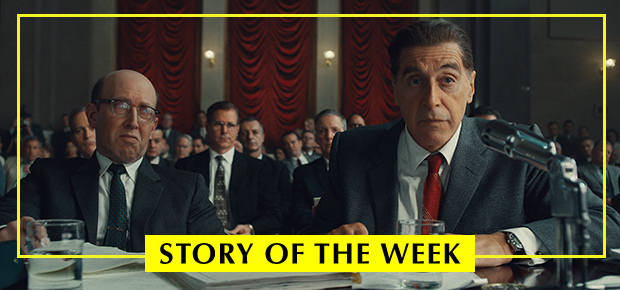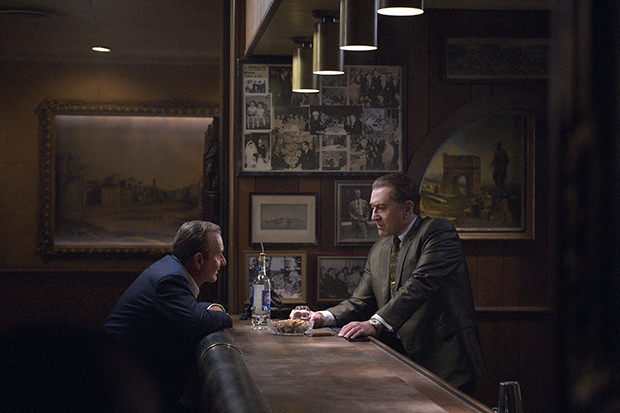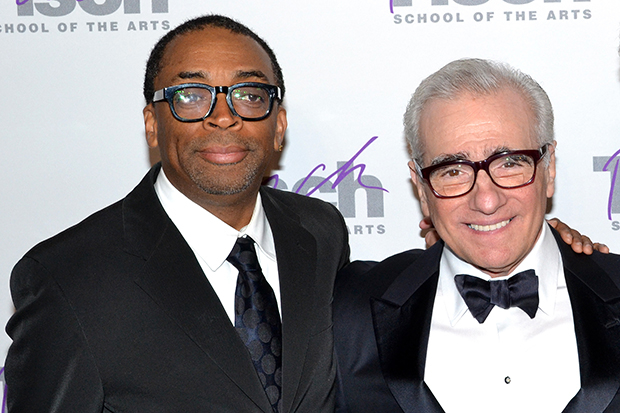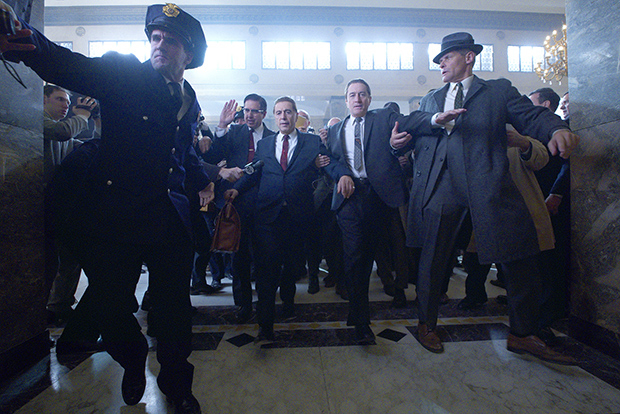What Is a Movie Doing in a Broadway Theater? The Irishman to Play the Belasco
Martin Scorsese’s new crime epic will have a limited screening engagement at the 44th Street venue.

(© Netflix)
This week we learned that, for the first time in its 112-year history, the Belasco Theatre on Broadway will play host to a movie: From November 1 to December 1, the new Martin Scorsese film The Irishman will have a typical Broadway schedule of eight screenings a week, with Mondays dark. Tickets go on sale through Telecharge next week.
The $159 million film is being distributed by Netflix, and will become available globally on the streaming platform on November 27. While film and theater lovers have largely rejoiced, some purists have raised an eyebrow at the impending arrival of this strange tenant in one of Broadway's most storied theaters.
This Story of the Week will explore why The Irishman is opening first for theatrical screening, and why the producers have chosen the Belasco as the New York venue.

(© Netflix)
What is The Irishman?
Based on the Charles Brandt's 2004 book I Heard You Paint Houses, The Irishman tells the story of Frank Sheeran, a World War II combat veteran who translated the skills he gained in the fields of Europe to a career as a Mafia hitman. While this was his real source of income, Sheeran was officially a truck driver and high-ranking official in the International Brotherhood of Teamsters. According to Brandt, Sheeran confessed at the end of his life to the murder of Jimmy Hoffa, the teamster union leader who disappeared in 1975, and the subject of a thousand conspiracy theories. The Irishman unpacks that story and unveils the stealthy infiltration of organized crime into all levels of American society.
Robert De Niro stars as Sheeran, with Al Pacino as Hoffa and Joe Pesci as crime boss Russell Bufalino, as well as featured performances by Bobby Cannavale, Ray Romano, Anna Paquin, and Harvey Keitel. As my colleague David Gordon pointed out, the cast also includes a slew of Broadway veterans including Kate Arrington, Louis Cancelmi, Rebecca Faulkenberry, and Jennifer Mudge.
Clocking in at three hours and 29 minutes, The Irishman is the latest in a string of lengthy Scorsese epics like Gangs of New York (two hours, 48 minutes) and The Wolf of Wall Street (three hours). No word yet on whether the Belasco screening will feature an intermission.
Why is it playing the Belasco Theatre?
The vast majority of viewers will experience The Irishman in the comfort of their own living rooms, where intermission arrives with a tap of the pause button. Streaming services like Netflix make it possible to watch shows and movies at any hour, anyplace you can bring a screen (I regularly see people watching Netflix programming on their phones in the subway). Unlike live theater (or traditional moviegoing), it is completely geared around your timetable.
So why bother with a theatrical release? Part of it surely has to do with Scorsese, a Hollywood veteran whose career spans half a century. Scorsese directs his films for the big screen, and traditionalists will argue that this is where they really ought to be seen. Plus, as a native New Yorker, Scorsese has always harbored a love of Broadway, so it feels like the perfect venue for his latest film.
But there's also the issue of awards: A big-budget epic by Martin Scorsese will almost certainly be in the running for the 2020 Academy Awards, but some filmmakers (including Steven Spielberg) feel that Netflix movies are actually TV movies, and should be considered by the Emmys. A theatrical release (however limited) mitigates some of that criticism, although expect the debate to heat up once again when the nominations are announced in January.

(© David Gordon)
Last year, Alfonso Cuarón's Netflix-distributed film Roma (which also received a limited theatrical release) came within striking distance of winning the Oscar for Best Picture (it won in the direction, cinematography, and foreign language categories). If The Irishman wins in 2020, it would represent a tectonic shift in the film industry, the ultimate indication that the business has changed forever and the future is streaming.
But when it comes to a changing industry, awards are a lagging indicator: "We've lost so many wonderful theaters in New York City in recent years, including single house theaters like the Ziegfeld and the Paris," said Scorsese in an official statement. "The opportunity to recreate that singular experience at the historic Belasco Theatre is incredibly exciting."
And there's really no better theater than the Belasco to make a night feel special. Named after impresario David Belasco (who allegedly still haunts the theater), it is my very favorite house on Broadway. The dramatic murals lit by ornate Tiffany lamps always make me feel like I'm stepping back in time. One of those murals (opposite the downstairs men's room) depicts a medieval execution. A priest blesses the scene (Belasco was called "the bishop of Broadway" for his eccentric habit of wearing clerical garb), and the condemned bears a striking resemblance to critic George Jean Nathan. (Can you think of a higher honor?) If you catch a screening of the film, you ought to go down and visit them.

(© Netflix)
Is this a desecration of Broadway?
I don't think so. Broadway theaters have served as movie houses in the past: The New Amsterdam (crown jewel of 42nd Street) became a cinema in the wake of the Great Depression. So did the Selwyn (now known as the American Airlines Theatre) across the street. Both have returned to hosting live performance.
The situation with the Belasco is different, though: Far from struggling to stay afloat, Broadway just had its best season ever in terms of receipts. Houses are rarely dark for long, and soon-to-be vacant theaters often have multiple producers circling them. The Irishman is playing a one-month limited run. It does not represent the permanent conversion of the Belasco into a movie house — and frankly, I think a Martin Scorsese historical drama is a much more appealing tenant for the Belasco than any of the tacky holiday concerts that seem to pop up on Broadway this time of year. So let's be confident in the trajectory of live theater, and let's go to the movies.









